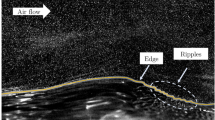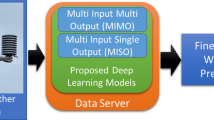Abstract
Wind energy is gaining importance owing to its renewable and environmentally friendly characteristics. However, the variability and stochastic nature of wind speed makes accurate forecasting difficult. Hence, this study introduces a novel approach (VMD-SCINet) for wind speed forecasting (WSF) by integrating the strengths of variational mode decomposition (VMD) and sample convolution and interaction network (SCINet) architecture for the prediction of wind speed. This study utilizes VMD as a denoising technique for wind speed data and incorporates SCINet to capture global patterns and long-range dependencies for the WSF. The wind speed data acquired from two distinct sites: Leicester, and Portland is used for the evaluation. To evaluate the WSF capability of the proposed hybrid model, it’s performance is compared to robust models using data from two wind farms across six different time horizons such as 5-min, 10-min, 15-min, 30-min, 1-hour, and 2-hours. The results from two experiments demonstrate that the proposed approach outperforms other models, leading to a significant improvement in WSF accuracy across all evaluated time intervals.








Similar content being viewed by others
Availability of Data and Materials
The datasets that support the conclusions of this study can be obtained from the corresponding author on reasonable request.
Abbreviations
- AI:
-
Artificial Intelligence
- ARIMA:
-
Autoregressive Integrated Moving Average
- ARMA:
-
Autoregressive Moving Average
- Bi-LSTM:
-
Bidirectional LSTM
- BiRNN:
-
Bidirectional RNN
- BPNN:
-
Back Propagation Neural Network
- CEEMDAN:
-
Complete Ensemble Empirical Mode Decomposition
- DLM:
-
Deep Learning Models
- DT:
-
Decision Tree
- EEMD:
-
Ensemble Empirical Mode Decomposition
- ELM:
-
Extreme Learning Machine
- EMD:
-
Empirical Mode Decomposition
- EWT:
-
Empirical Wavelet Transform
- IMF:
-
Intrinsic Mode Function
- KNN:
-
K-Nearest Neighbours
- LSTM:
-
Kernel Method Based Support Vector Regression
- k-SVR:
-
Long Short Term Memory
- MAE:
-
Mean Absolute Error
- MLM:
-
Machine Learning Models
- MSE:
-
Mean Square Error
- RF:
-
Random Forest
- RMSE:
-
Root Mean Square Error
- RNN:
-
Recurrent Neural Network
- \(R^2\) :
-
R-Square Score
- SARIMA:
-
Seasonal Autoregressive Moving Average
- SCINet:
-
Sample Convolution and Interaction Network
- SSA:
-
Singular Spectrum Analysis
- TCN:
-
Temporal Convolutional Network
- VMD:
-
Variational Mode Decomposition
- WSF:
-
Wind Speed Forecasting
- WT:
-
Wavelet Transform
- 1D-CNN:
-
1-Dimensional Convolutional Neural Network
References
Al-Duais FS, Al-Sharpi RS (2023) A unique markov chain monte carlo method for forecasting wind power utilizing time series model. Alex Eng J 74:51–63
Bentsen LØ, Warakagoda ND, Stenbro R, Engelstad P (2023) Spatio-temporal wind speed forecasting using graph networks and novel transformer architectures. Appl Energy 333:120565
Bommidi BS, Kosana V, Teeparthi K, Madasthu S (2023) Hybrid attention-based temporal convolutional bidirectional lstm approach for wind speed interval prediction. Environ Sci Pollut Res 1–13
Bommidi BS, Teeparthi K, Kosana V (2023) Hybrid wind speed forecasting using iceemdan and transformer model with novel loss function. Energy 265:126383
Bonventi W Jr, Godoy EP (2021) Fuzzy logic for renewable energy recommendation and regional consumption forecast using sarima and lstm. J Renewable and Sustain Energy 15(2):026101
Dragomiretskiy K, Zosso D (2014) Variational mode decomposition. IEEE Trans Signal Process 62(3):531–544. https://doi.org/10.1109/TSP.2013.2288675
Duan J, Zuo H, Bai Y, Duan J, Chang M, Chen B (2021) Short-term wind speed forecasting using recurrent neural networks with error correction. Energy 217:119397
Gani A (2021) Fossil fuel energy and environmental performance in an extended stirpat model. J Clean Prod 297:126526
Huang S-C, Chiou C-C, Chiang J-T, Wu C-F (2020) A novel intelligent option price forecasting and trading system by multiple kernel adaptive filters. J Comput Appl Math 369:112560
Jiang P, Liu Z, Wang J, Zhang L (2021) Decomposition-selection-ensemble forecasting system for energy futures price forecasting based on multi-objective version of chaos game optimization algorithm. Resources Policy 73:102234
Jiang B, Liu Y, Xie H (2023) Super short-term wind speed prediction based on ceemd decomposition and bilstm-transformer model. 2023 IEEE 3rd International Conference on Power. Electronics and Computer Applications (ICPECA), IEEE, pp 876–882
Li G, Shi J (2010) On comparing three artificial neural networks for wind speed forecasting. Appl Energy 87(7):2313–2320
Li C, Zhu Z, Yang H, Li R (2019) An innovative hybrid system for wind speed forecasting based on fuzzy preprocessing scheme and multi-objective optimization. Energy 174:1219–1237
Li L-L, Chang Y-B, Tseng M-L, Liu J-Q, Lim MK (2020) Wind power prediction using a novel model on wavelet decomposition-support vector machines-improved atomic search algorithm. J Clean Prod 270:121817
Liang T, Zhao Q, Lv Q, Sun H (2021) A novel wind speed prediction strategy based on bi-lstm, moofada and transfer learning for centralized control centers. Energy 230:120904
Liu H, Mi X, Li Y (2018) Smart multi-step deep learning model for wind speed forecasting based on variational mode decomposition, singular spectrum analysis, lstm network and elm. Energy Convers Manag 159:54–64
Liu M, Cao Z, Zhang J, Wang L, Huang C, Luo X (2020) Short-term wind speed forecasting based on the jaya-svm model. Int J Electr Power Energy Syst 121:106056
Liu M, Zeng A, Chen M, Xu Z, Lai Q, Ma L, Xu Q (2022) Scinet: time series modeling and forecasting with sample convolution and interaction. Adv Neural Inf Process Syst 35:5816–5828
Nascimento EGS, Melo TA, Moreira DM (2023) A transformer-based deep neural network with wavelet transform for forecasting wind speed and wind energy. Energy 278:127678
National Renewable Energy Laboratory’s Western Wind Integration Dataset. https://www.nrel.gov/grid/western-wind-data.html. Accessed on November 2022
Suo L, Peng T, Song S, Zhang C, Wang Y, Fu Y, Nazir MS (2023) Wind speed prediction by a swarm intelligence based deep learning model via signal decomposition and parameter optimization using improved chimp optimization algorithm. Energy 276:127526
Wang J, Zhang W, Li Y, Wang J, Dang Z (2014) Forecasting wind speed using empirical mode decomposition and elman neural network. Appl Soft Comput 23:452–459
Wang S, Zhang N, Wu L, Wang Y (2016) Wind speed forecasting based on the hybrid ensemble empirical mode decomposition and ga-bp neural network method. Renew Energy 94:629–636
Wang J, Wang Y, Li Z, Li H, Yang H (2020) A combined framework based on data preprocessing, neural networks and multi-tracker optimizer for wind speed prediction. Sustain Energy Technol Assess 40:100757
Wang Y, Wang J, Li Z (2020) A novel hybrid air quality early-warning system based on phase-space reconstruction and multi-objective optimization: A case study in china. J Clean Prod 260:121027
Yang W, Hao M, Hao Y (2023) Innovative ensemble system based on mixed frequency modeling for wind speed point and interval forecasting. Inf Sci 622:560–586
Yao W, Huang P, Jia Z (2018) Multidimensional lstm networks to predict wind speed. In: 2018 37th Chinese Control Conference (CCC), IEEE, pp 7493–7497
Zhang Z, Wang J, Wei D, Luo T, Xia Y (2023) A novel ensemble system for short-term wind speed forecasting based on two-stage attention-based recurrent neural network. Renew Energy
Zhao Z, Yun S, Jia L, Guo J, Meng Y, He N, Li X, Shi J, Yang L (2023) Hybrid vmd-cnn-gru-based model for short-term forecasting of wind power considering spatio-temporal features. Eng Appl Artif Intell 121:105982
Zhu X, Liu R, Chen Y, Gao X, Wang Y, Xu Z (2021) Wind speed behaviors feather analysis and its utilization on wind speed prediction using 3d-cnn. Energy 236:121523
Funding
The authors received no funding for conducting this study.
Author information
Authors and Affiliations
Contributions
Srihari Parri: Conceptualization, methodology, software. visualization, performed the experiments. Kiran Teeparthi: writing - review & editing, supervision, validation.
Corresponding author
Ethics declarations
Competing interest
The authors declare no competing interests.
Ethical Approval
Not applicable.
Consent for Publication
Not applicable.
Additional information
Communicated by: H. Babaie.
Publisher's Note
Springer Nature remains neutral with regard to jurisdictional claims in published maps and institutional affiliations.
Rights and permissions
Springer Nature or its licensor (e.g. a society or other partner) holds exclusive rights to this article under a publishing agreement with the author(s) or other rightsholder(s); author self-archiving of the accepted manuscript version of this article is solely governed by the terms of such publishing agreement and applicable law.
About this article
Cite this article
Parri, S., Teeparthi, K. VMD-SCINet: a hybrid model for improved wind speed forecasting. Earth Sci Inform 17, 329–350 (2024). https://doi.org/10.1007/s12145-023-01169-3
Received:
Accepted:
Published:
Issue Date:
DOI: https://doi.org/10.1007/s12145-023-01169-3




